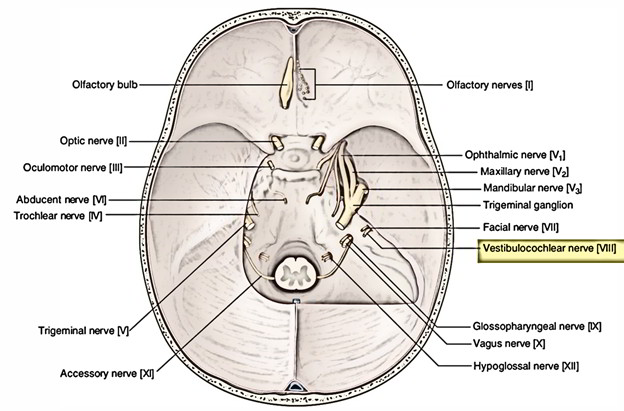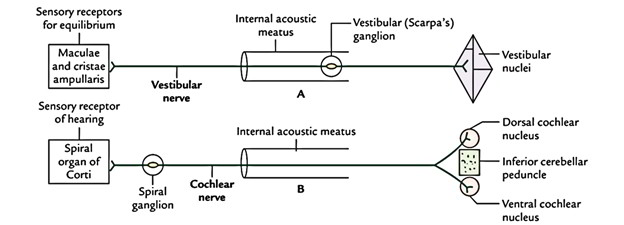It contains 2 different parts: (a) a vestibular part, referred to as the vestibularnerve and (b) a cochlear part, named the cochlear nerve. Vestibulocochlear nerve is the 8th cranial nerve. The vestibular nerve is concerned with the maintenance of equilibrium, while the cochlear nerve is concerned with hearing.
Functional Component and Nuclei
Special somatic afferent fibres: They carry sensory infor-mation essential for the maintenance of equilibrium and hearing from the membranous labyrinth of the internal ear.
The fibres carrying the sensory info for equilib-rium terminate in the vestibular nuclei inside the brainstem.
The fibres carrying the sensory info for hearing terminate in the dorsal and ventral cochlear nuclei are found, respectively, on the dorsal and ventral aspects of the inferior cerebellar peduncle.
Course and Relationships
- The vestibular nerve originates from the lateral aspect of the pontomedullary junction, goes through the pontocerebel-lar angle and enters the internal acoustic meatus together with the facial nerve and labyrinthine vessels.
- The vestibular ganglion (also named Scarpa’s ganglion) lies on the vestibular nerve in the lateral part of the inter-nal acoustic meatus. It contains bipolar sensory neurons. In the lateral part of the internal acoustic meatus, the nerve splits into 3 distinct branches: superior and inferior divisions and remarkable nerve.
- These branches go through the foramina in the fundus of the meatus and innervate the sensory receptors for equilibrium (cristae ampullaris and maculae) in the membranous labyrinth of the internal ear.
- The cochlear nerve also originates from the lateral aspect of the pontomedullary junction and requires a quite similar course to go into the internal acoustic meatus. At the medial end of the internal acoustic meatus, it enters into bony labyrinth of the middle ear via tractus spiralis foraminosus in the fundus of the meatus and reaches the modiolus of the internal ear.
- In the modiolus, the cochlear nerve possesses a sensory ganglion referred to as the spiral ganglion made of bipolar neurons. The peripheral process of these neurons innervates the sensory receptor of hearing-the organ of Corti.
Clinical Significance
Lesions of Vestibulocochlear Nerve
The lesions of thevestibulo-cochlear nerve medically present as:
- Tinnitus (ringing or buzzing in the ears)
- Damage or loss of hearing
- Decline of balance (vertigo)
The vestibular nerve is normally demanded by acoustic neuroma, which originates from the sheath cells of its constituent fibres in the region of cerebellopontine angle. The acoustic neuroma is among the common intracranial tumors and if large, it might affect the adjacent trigeminal, facial and glossopharyngeal nerves and could compress cerebellum and medulla.



 (58 votes, average: 4.52 out of 5)
(58 votes, average: 4.52 out of 5)